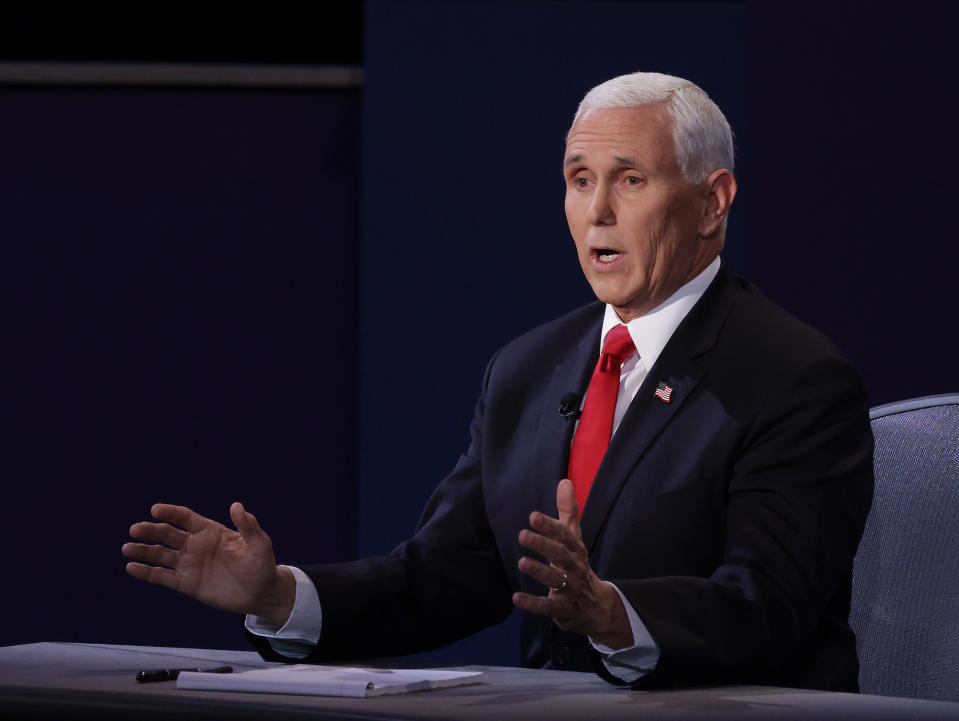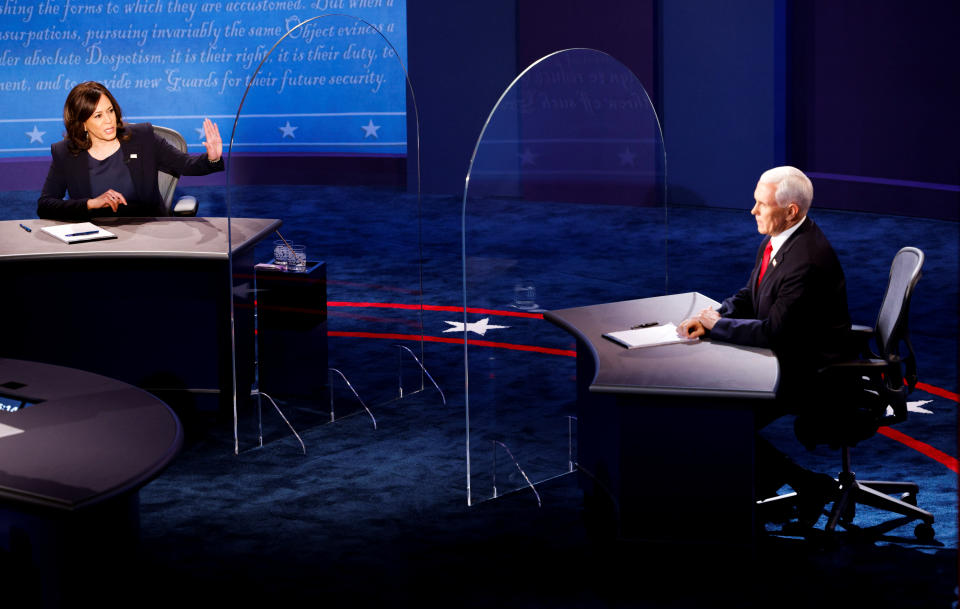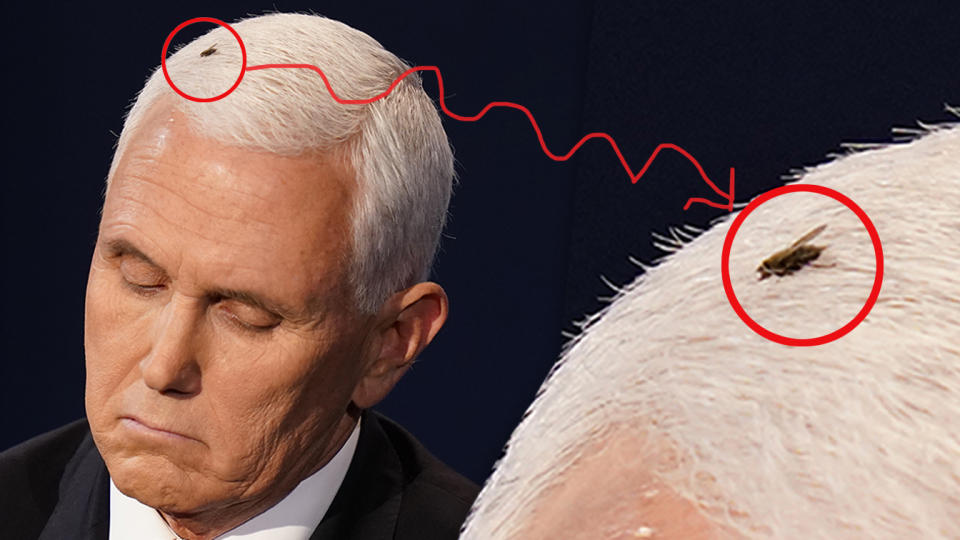4 takeaways from a weirdly normal vice presidential debate between Mike Pence and Kamala Harris
One week after President Trump’s aggressive interruptions of former Vice President Joe Biden turned the first presidential debate of 2020 into one of the most juvenile spectacles in campaign history, Wednesday’s face-off between Sen. Kamala Harris and Vice President Mike Pence felt downright normal by comparison.
Pundits had predicted that the meeting could be the most (read: only) consequential VP debate ever, and with its endless, dizzying plot twists — including Trump’s recent hospitalization for COVID-19 and a growing cluster of infections in the upper echelons of the Republican Party — the 2020 campaign has conditioned viewers to expect nothing less.
Yet for all the buildup, the most exciting moment of the entire affair in Salt Lake City was when a fly landed on Pence’s snow-white mane and decided to rest there for two minutes.
And that’s OK. Not every development in presidential politics has to be unprecedented. In fact, an actual debate in which the candidates engaged in actual candidate behavior — like delivering a talking point, or completing a sentence — came as something of a relief. And for anyone trying to decipher what Trump and Biden intend to do as president, Pence and Harris turned out to be much sharper and more strategic messengers than the men they’re running with.
Here are four takeaways from the debate.
_____
Kamala kept the focus on the pandemic

As the most important topic in the country, COVID-19 was, predictably, the first question of the night: What would a Biden-Harris administration do to combat the pandemic that a Trump-Pence administration wouldn’t? Just as predictably, Harris, a former San Francisco district attorney and California attorney general, answered the way she’s always said she would: by prosecuting the case against Trump.
“The American people have witnessed what is the greatest failure of any presidential administration in the history of our country,” Harris said. “Here are the facts: 210,000 dead people in our country in just the last several months. Over 7 million people who have contracted this disease. One in five businesses closed.”
Citing the revelatory recordings from the Washington Post reporter Bob Woodward, Harris went on to accuse Trump and Pence of knowing “on Jan. 28” that the virus is “lethal in consequence, that it is airborne, that it will affect young people,” but “cover[ing] it up” because they wanted Americans to remain “calm.”
“Can you imagine if you knew on Jan. 28 what they knew … what you would have done to prepare?” Harris asked the audience. “How calm were you when you were panicked about where you were going to get your next roll of toilet paper? How calm were you when your kids were sent home from school, and you didn’t know when they would go back? How calm were you when your children couldn’t see your parents because you were afraid they could kill them?”
During the Democratic primary, Harris was more focused on manufacturing memorable moments than hammering home a message. Remember, she initially captured the national spotlight when her barbed interrogations of Trump’s Cabinet appointees were cut into viral videos highlighting her prosecutorial prowess — and that’s largely how she conducted herself during the primary (like when she eviscerated Biden on busing).
But Wednesday night was different. Again and again, Harris skillfully dodged questions that it wasn’t in Joe Biden’s best interest to answer: on China, on presidential disability, on expanding the size of the Supreme Court. (Pence did the same when asked if he’d want Indiana to outlaw all abortions.) Instead, whenever the moderator, Susan Page of USA Today, tried to ask about other topics, Harris always pivoted back to the pandemic — and the possible fallout of Trump’s efforts to axe the Affordable Care Act, including the end of protections for pre-existing conditions.
Her mission was clear: Remind voters (as she repeated at least a half dozen times) that “over 210,000” Americans have died from COVID-19. Her message was even clearer: Trump and Pence had their chance to keep you safe — and they failed.
Pence tried to smooth Trump’s rough edges

Pence probably had the more challenging goal on Wednesday: To try to make his divisive boss, who is disapproved of by a majority of Americans and trailing by double digits in the latest election polls, palatable to the remaining persuadable voters who could still tip the election to the Republican ticket.
As usual, the mild-mannered Hoosier devoted himself to the task at hand with all the aw-shucks moxie he could muster, and his smooth affect came in handy as he methodically attempted to sand the rough edges off every controversial aspect of Trump’s record.
The New York Times report that Trump only paid $750 in federal income taxes during his first year as president? Pence countered that it was simply a sign that, as a businessman, Trump had dedicated his life to creating “tens of thousands of American jobs.”
That maskless Rose Garden announcement ceremony for Supreme Court nominee Amy Coney Barrett, which has since been tied to a growing cluster of COVID-19 cases in and around the White House? Just another example of how “President Trump and I trust the American people to make choices in the best interest of their health.”
Trump’s reluctance to condemn white supremacists during the first presidential debate? Nothing but more evidence of how “the media” chooses to “selectively edit” a president who “respects and cherishes all of the American people.”
Trump seemed happy with Pence’s performance. “Mike Pence is doing GREAT!” he tweeted at one point. “Mike Pence WON BIG!” he added later. And it’s not hard to see why: The vice president did his level best to reframe the abnormalities of Trump’s presidency in the ho-hum terms and tone of everyday American politics, while also arguing that Biden would be worse.
But the question now is whether Pence’s efforts will make any difference. Nothing this year has discernibly changed the public’s opinion of Trump — not impeachment, not a racial reckoning in the streets, not even a global pandemic. Instead, those events seem to have solidified the president’s high disapproval rating and low standing in the polls.
It’s unlikely that one measured debate performance by his running mate will shift many votes.
Harris didn’t tolerate Pence’s interruptions

During last week’s presidential debate, Trump was responsible for more than three-quarters of the interruptions: 71, compared with Biden’s 22.
The event was an unintelligible, chaotic mess because of it.
Harris, however, seemed to arrive in Salt Lake City on Wednesday with a plan: to take Pence to task the second he made so much as a peep during her turn to talk.
“Mr. Vice President, I’m speaking,” the senator said, when Pence tried to contradict her remarks on COVID-19. “I’m speaking.”
“Mr. Vice President, I’m speaking,” she said when he tried to interject as she was discussing the Supreme Court. “I’m speaking.”
“Mr. Vice President, I’m speaking,” she said when he accused her of lying about the economy.
“It would be important if you said the truth,” Pence snapped.
“If you don’t mind letting me finish,” Harris snapped back, “we can then have a conversation, OK?’
Ultimately, Pence interrupted Harris 10 times — twice as much as she interrupted him, according to CBS News. But the debate never spun out of control, in part because Harris was so swift to call Pence out.
The tactic also had another, subtler effect. One of the most interesting questions heading into the debate was how Harris’s gender and race — she’s the first woman of color on a major-party presidential ticket — would influence the dynamic onstage. Would viewers stereotype her as “an angry black woman” if she acted assertively? According to Axios, Harris’s advisers “studied research about the different ways men and women are judged in public speaking.” They apparently concluded that Harris would look strong if she stuck up for herself — even as she took care to avoid any big rhetorical risks or made-for-TV moments.
The fly seen ’round the world

One hour and 13 minutes into the debate, as Pence was answering a question about racial justice, a fly evaded event security and alighted on the vice president’s head. For the next 120 seconds or so — an eternity in televisual time — all anyone watching could wonder was, “When is that thing going to fly away?”
And then, suddenly, it did. Our rare moment of national unity was over.
Or was it? Within minutes, the Biden campaign capitalized on a surge in fly-related search traffic with a tweet that showed Biden sitting at a folding table, holding a fly swatter, poised to pounce. “Pitch in $5 to help this campaign fly,” read the caption. The accompanying link opened a fundraising page.
Thirty minutes later, the campaign added a royal-blue fly swatter to its merchandise store. “Truth over flies” was inscribed on the handle. The cost was $10 — roughly five times as much as the top-ranked fly swatter on Amazon.com.
Judging by online activity in the hours after the debate ended, the fly may wind up being the only thing history recalls about an otherwise quotidian encounter. Which, of course, would suit 2020’s style. Amid all the partisanship and polarization, who knew the one thing that could bring the American people together was a bug in the wrong place at the right time?
Cover thumbnail photos: Justin Sullivan/Pool via Getty Images (2)
_____
Read more from Yahoo News:

 Yahoo Finance
Yahoo Finance 



